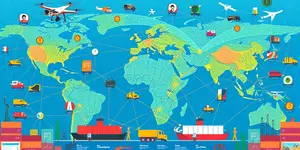
The global education landscape is undergoing a profound transformation. Accelerated by digital tools, evolving pedagogies, and unprecedented market growth, EdTech stands at the forefront of revolutionizing how we learn and teach.
From immersive virtual experiences to AI-powered platforms, the possibilities are boundless. As educators, investors, and learners converge, this era promises both substantial financial returns and market expansion and a dramatic uplift in educational outcomes worldwide.
In 2024, the global EdTech market is valued between USD 158.5 and 250.16 billion. By 2025, it is projected to reach USD 181.3–187.02 billion, and forecasts suggest it could soar to USD 348.41 billion by 2030. Long-term estimates place the market at around USD 421 billion in 2032 and an astonishing USD 646.8–721.15 billion by 2033.
This growth translates to a robust compound annual growth rate of 11.86%–14.2% from 2025 to 2033, outpacing many traditional sectors. North America leads with a 36%–39% share, while emerging markets in Asia offer untapped potential.
Several powerful forces are propelling the EdTech revolution:
Leading-edge technologies are redefining the learner’s journey. From adaptive platforms to immersive realities, the future classroom is dynamic, responsive, and personalized.
Real-world implementations highlight the transformative potential of EdTech. Students engage through interactive simulations, teachers leverage data analytics for targeted support, and organizations deliver scalable training.
Despite impressive gains, significant hurdles remain. The digital divide leaves millions without reliable access or training to effectively integrate EdTech tools. Open-source content disrupts traditional business models, and venture capital funding, at USD 1.8 billion in 2024, lags behind the sector’s potential.
Educators report that 60% lack sufficient training to implement new platforms, and in some regions, up to 75% cite inadequate infrastructure. These disparities risk leaving underserved communities further behind as technology advances.
Addressing these barriers requires collaborative effort. Governments, private investors, and non-profits must join forces to fund infrastructure upgrades and professional development programs. Establishing public-private partnerships can drive large-scale digital literacy initiatives, ensuring teachers and students alike are well-equipped.
Open-source collaborations and transparent policy frameworks can balance innovation with sustainability. By incentivizing affordable solutions and fostering a culture of continuous learning, stakeholders can cultivate resilient educational ecosystems that adapt to evolving needs.
Emerging markets present a fertile ground for expansion. Countries such as India and China are investing heavily in broadband infrastructure and digital platforms, creating opportunities for localized solutions. Cross-border collaborations and international standards can accelerate adoption and interoperability.
Looking ahead, trends such as workforce re-skilling, the integration of metaverse environments, and heightened focus on data privacy will shape the next phase of growth. Educators and technology providers who embrace ethical AI, inclusive design, and evidence-based practices will lead the charge.
The future of learning hinges on our collective commitment to innovation and equity. By channeling the momentum of this booming market into purposeful solutions, we can unlock human potential on a global scale.
As investors, educators, and learners, we stand at a crossroads. Choosing to harness the power of EdTech with vision, compassion, and rigor will not only yield substantial financial returns and market expansion but also foster a world where education becomes a universal catalyst for growth and opportunity.
References













